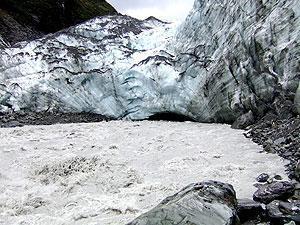Could increased chemical weathering of rocks by rivers increase the absorption of carbon dioxide from the atmosphere and so regulate the planet’s temperature?
Ocean chemistry is affected by the chemical breakdown of continental rocks by rain and ground water, according to UK scientists. Their research published in Nature points to how climate change affects this breakdown and could have important implications for understanding Earth’s history.

Sediment-charged waters disgorge from beneath the Franz Josef Glacier, New Zealand. (Credit: Damon Teagle)
Derek Vance of the University of Bristol and colleague Gavin Foster and Damon Teagle of the University of Southampton explain that one of the most profound effects is seen with the ebb and flow of Ice Age over the last 2-3 million years.
It has been known for a long time that rivers and submarine volcanic activity together are important for the mineral content of the oceans. Another factor is the absorption by rocks on the ocean floor and shell-making marine creatures leads to the accumulation of undissolved minerals being deposited as sediment. However, chemical weathering of rocks over which rivers pass on their way to the sea is also a major source of dissolved minerals. Run off from rivers is probably more important than volcanic activity. An imbalance in the inputs and outputs cause changes in the chemical make-up of the oceans over time.
Vance and colleagues have looked at the record of past ocean chemistry preserved in deep-sea sediments to reveal how seawater chemistry has changed over the past 2-3 million years. Their results challenge the received wisdom concerning the relative impact of submarine hydrothermal systems and river run off. They suggest that continental chemical weathering rates affected by profound climate change could have a much greater impact than previously thought.
Chemical weathering rates have been periodically perturbed in recent Earth history because the ice-sheets and glaciers produced during the great ice ages have physically ground rock up to smaller and smaller grain sizes. In the succeeding hotter and wetter ‘interglacial’ periods, this ground up rock is very susceptible to chemical weathering, Vance explains.
Vance and colleagues are offering a different perspective. Their work suggests that the flow of dissolved constituents to the oceans via rivers is much more temporally dynamic than previously thought and that the reason for the dynamism is the ebb and flow of ice.
Physical weathering, the mechanical breakdown of rock into smaller and smaller grain sizes, leads to faster chemical weathering, more surface area, Vance told Spotlight, The process of chemical weathering itself consumes carbon dioxide in the chemical reaction that is chemical weathering.
This material reaches the oceans where it provides the raw materials for the calcium carbonate shells of marine organisms, which drop to the ocean floor as sediment when the creatures die. As chemical weathering happens more quickly as temperatures rise, this might provide a regulatory mechanism for the Earth’s climate on the million-year timescale.
However, this cycle of chemical weathering and carbon dioxide absorption is very slow. This means that in periods like the last 2-3 million years, higher chemical weathering rates could act to maintain ‘icehouse’ conditions once they have started, explains Bristol’s Gavin Foster. No one should make the mistake of thinking that these processes could extract us from the modern predicament of high and rising atmospheric carbon dioxide because the natural processes occur on geological timescales of hundreds of thousands to millions of years, adds Foster, and so are not relevant to the short span of modern industrialised society.
Further reading
Nature, 2009; 458, 493
http://dx.doi.org/10.1038/nature07828
Dr Derek Vance’s homepage
http://www.gly.bris.ac.uk/people/dv.html
Dr Gavin Foster ‘s homepage
http://www.gly.bris.ac.uk/people/glf.html
Dr Damon A.H. Teagle’s homepage
http://www.wun.ac.uk/view.php?id=195
Suggested searches
climate change
chemical weathering
ocean chemistry